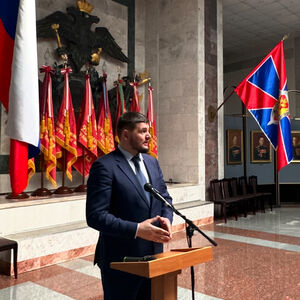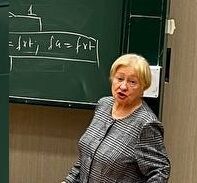Диссертация (1140677), страница 18
Текст из файла (страница 18)
In: Lau CP (ed.), Rate Adaptive Cardiac Pacing. Armonk. - NY: FuturaPublishing Co Inc, 1993. – Ch. 5, - P. 51–62.70. Left anterior descending coronary artery flow impaired by right ventricularapical pacing: The role of systolic dyssynchrony / F. Fang, Z. N. Jin, H. Y. Li,et al.
//International Journal of Cardiology. – 2014. –176 (1). –P. 80-5.10871. Left ventricular function during and after right ventricular pacing / M. Nahlawi,M. Waligora, S. M. Spies, et. al. // J Am Coll Cardiol. – 2004. – 44 (9). – P.1883-8.72. LIFE Study Results.
A blended sensor restores chronotropic response morefavorably than accelerometer alone in pacemaker patients: the LIFE studyresults / J. Coman, R. Freedman, B. A. Koplan, et al. // Pacing ClinElectrophysiol. – 2008. – 31 (11). – P. 1433-42.73. Long- term outcomes in patients with atrioventricular block undergoing septalventricular lead implantation compared with standart apical pacing / A. Kypta,C. Steinwender, J. Kammler, et.
al. // Europace. – 2008. –10 (5). – P. 574–9.74. Long-term follow-up of patients from a randomised trial of atrial versusventricular pacing for sick-sinus syndrome /H. R. Andersen, J. C. Nielsen, P. E.Thomsen, et al. // Lancet. – 1997. – 350. – P. 1210.75. Mapping of regional myocardial strain and work during ventricular pacing:experimental study using magnetic resonance imaging tagging / F. W. Prinzen,W.
S. Hunter, B. T. Wyman, E. R. McVeigh // J Am Coll Cardiol. –1999. – 33(6). – 1735-42.76. McElroy, P. A. Physiologic correlates of the heart rate response to uprightisotonic exercise: relevance to rate-responsive pacemakers / P. A. McElroy, J. S.Janicki, K. T. Weber // J Am Coll Cardiol. – 1988. - 11 (1). – P. 94-9.77. Medium and long-term survival after pacemaker implant: Improved survivalwith right ventricular outflow tract pacing / G. Vanerio, J.
L. Vidal,P.Fernandez Banizi, et al. // J Interv Card Electrophysiol. – 2008. – 21(3). – P.195–201.78.Melzer, C. Chronotropic incompetence: a never-ending story/ C. Melzer, H.Dreger // Europace. –2010. – 12(4). –P. 464-5.79. Modulation of the arterial coronary blood flow by asynchronous activation withventricular pacing / G.
Amitzur, D. Manor, A. Pressman, et al. // Pacing ClinElectrophysiol. – 1995. – 18 (4 Pt 1). – P. 697-710.10980. Myers, J. Clinical, hemodynamic, and cardiopulmonary exercise testdeterminants of outcomes in patients referred for evaluation of heart failure /Myers J. // Ann Intern Med. -1998.
–129. – P. 286-93.81. Myocardial perfusion in patients with permanent ventricular pacing and normalcoronary arteries / E. I. Skalidis, G. E. Kochiadakis, S. I. Koukouraki, et al. // JAm Coll Cardiol. –2001. –37 (1). – 124-9.82. Myocardial perfusion SPECT identifies patients with left bundle branch blockpatterns at high risk for future coronary events / T. J.
Ten Cate, J. C. Kelder, H.W. Plokker, et al. // J Nucl Cardiol. – 2010. – 17(2). – P. 216-24.83.Nagele, H. Rate-responsive pacing in patients with heart failure: long-termresults of a randomized study / H. Nagele, W. Rodiger, M. A. Castel // Europace.– 2008. –10. – P. 1182-88.84.Nonivasive pacemaker stress echocardiography for diagnosis of coronaryartery disease / E.
Picano, A. Alaimo, V. Chubuchny, et al. // J Am Cardiol. –2002. – 40 (7). – P. 1305-10.85. Oxygen utilization and ventilation during exercise in patients with chroniccardiac failure / K. T. Weber, G. T. Kinasewitz, J. S. Janicki, A. P. Fishman //Circulation. – 1982. – 65 (6). – P. 1213-23.86. Pacemaker stress echocardiography predicts cardiac events in patients withpermanent pacemaker / E. Biagini, A. F. Schinkel, A. Elhendy, et al. // TheAmerican Journal of Medicine. –2005. – 118 (12).
– P. 1381-6.87. Pacemaker-related myocardial perfusion defects worsen during higher pacingrate and coronary flow augmentation / T. J. F. Ten Cate, F. C. Visser, N. M.Panhuyzen-Goedkoop, et al. // Heart Rhythm. – 2005. – 2. – P. 1058-63.88. Predicting maximal heart rate in heart failure patients on beta-blockade therapy /S. J. Keteyian, D. Kitzman, F. Zannad, et. al. // Med Sci Sports Exerc. – 2012. –44. –P. 371-76.89.
Prognostic value of exercise stress myocardial perfusion imaging in patientswith permanent pacemakers /A. C. Lapeyre III, I. G. Poornima, T. D. Miller, etal. //Am J Cardiol. – 2004. – 94 (6). – P. 811-14.11090. Proportionality of rate response to metabolic workload provided by a rateadaptive pacemaker with automatic rate profile optimization / P. Schuster, S.Faerestrand, O. J. Ohm, V. Schouten //Europace. – 2005. – 7. – P. 54-9.91. Quality of life and clinical outcomes in elderly patients treated with ventricularpacing as compared with dual-chamber pacing / G.
A. Lamas, E. J. Orav, B. S.Stambler, et al. // N Engl J Med. – 1998. – 338. –P. 1097–1104.92. Rate responsive pacemakers: a rapid assessment protocol / J. D. Shaber, J. D.Fisher, I. Ramachandra, et al. // PACE. – 2008. – 31. – P. 192-7.93. Regional myocardial blood flow in patients with sick sinus syndromerandomized to long-term single chamber atrial or dual chamber pacing –effect ofpacing mode and rate / J. C.
Nielsen, M. Bottcher, T. T. Nielsen, et al. // J AnColl Cardiol. – 2000. – 35. – P. 1453-61.94. Regulation of stroke volume during submaximal and maximal upright exercise innormal man / M. B. Higginbotham, K. G. Morris, R. S. Williams, et al. // CircRes. – 1986. – 58. –P. 281-91.95.
Relative importance of activation sequence compared to atrioventricularsynchrony in left ventricular function / Rosenqvist M, Isaaz K, Botvinick E, et al.// Am J Cardiol. – 1991. – 67(2). – P. 148-56.96. Reproducibility of the six-minute walking test in patients with chroniccongestive heart failure: practical implications / C. Opasich, G.
D. Pinna, A.Mazza, et al. // Am J Cardiol. – 1998. – 81. – P. 1497 – 1500.97. Reversible left ventricular dyssynchrony and heart failure induced by rightventricular pacing / J. W. Fung, Q. Zhang, G. W. Yip, C. M. Yu // Int J Cardiol.– 2008. –134. –P. 117-19.98. Right ventricular outflow and apical pacing comparably worsen theechocardioghraphic normal left ventricle / T.
J. F. Ten Cate, M. G. Scheffer, G.R. Sutherland, et al. //European Journal of Echocardiography. – 2008. – 9. – P.672-7.99. Right ventricular pacing can induce ventricular dyssynchrony in patients withatrial fibrillation after atrioventricular node ablation / L. F. Tops, M. J. Schalij,111E. R. Holman, et al. // J Am Coll Cardiol. – 2006.
– 48 (8). – P. 1642–8.100. Right Ventricular Septal Pacing Preserves Global Left Ventricular LongitudinalFunction in Comparison With Apical Pacing. Analysis of Speckle TrackingEchocardiography / K. Inoue, H. Okayama, K. Nishimura, et al. // Circ J.– 2011.- 75 (7). –P. 1609 – 15.101. Selection and treatment of candidates for heart transplantation. A statement forhealth professionals from the Committee on Heart Failure and CardiacTransplantation of the Council on Clinical Cardiology, American HeartAssociation / M. R.
Costanzo, S. Augustine, R. Bourge, et al. // Circulation1995.– №92. – P. 3593–3612.102. Single-chamber cardiac pacing with activity-initiated chronotropic response,evaluation by cardiopulmonary testing / D. G. Benditt, M. Mianulli, J. Fetter, etal. // Circulation. – 1987. – 75. –P. 184–91.103.
Speckle-Tracking Radial Strain Reveals Left Ventricular Dyssynchronyin Patients With Permanent Right Ventricular Pacing / L. F. Tops, M. S.Suffoletto, G. B. Bleeker, et al. // J Am Coll Cardiol. – 2007. – 50 (12). – P.1180–8.104. Stellenwert der Spiroergometrie und Streßechokardiographie zur optimiertenProgrammierung der oberen Grenzfrequenz von Zweikammerschrittmachern / S.Krüger, C. Stellbrink, J. Frielingsdorf, et al. // Z Kardiol.
– 1998. – 87 (10). –P.817–25.105. Strobel, J. S. Programming of sensor driven pacemakers / J. S. Strobel, G. N.Kay // Cardiol Clin. – 2000. –18(1). –157-76.106. Sweeney, M. O. Heart failure during cardiac pacing / M. O. Sweeney, A. S.Hellkamp // Circulation. – 2006. – 113. – P. 2082-88.107. Symptomatology and quality of life in patients with rate-responsive pacemakersa double blind cross-over study / C.
P. Lau, J. Rushby, M. Leigh-Jones, et al. //Clin Cardiol. – 1989. -12. –P. 505–12.108. Ten Cate, T. J. Myocardial perfusion defects in right ventricular apical pacingare caused by partial volume effects due to wall motion abnormalities. A new112model to study gated myocardial SPECT with the pacemaker on and off / T. J.Ten Cate, N. M. Van Hemel, J.
F. Verzijlbergen // Nuclear MedicineCommunications. – 2009. – 30 (6). – P. 480-84.109. The clinical implications of cumulative right ventricular pacing in themulticenter automatic defibrillator trial II / J. Steinberg, A. Fischer, P. Wang, etal. // J Cardiovasc Electrophysiol. – 2005. –16(4). – P. 359-65.110. The Incremental Benefit of Rate-Adaptive Pacing on Exercise PerformanceDuring Cardiac Resynchronization Therapy / H. F.
Tse, C. W. Siu, K. L. Lee, etal. // J Am Coll Cardiol. – 2005. – 46 (12). – P. 2292–7.111. The prognostic significance of typical perfusion defects on vasodilator stressmyocardial perfusion SPECT in patients with left bundle branch block or rightventricular apical pacing / T. J. Ten Cate, J. C. Kelder, M. D. Bogaard, et al.. //Nuclear Medicine Communications.
















